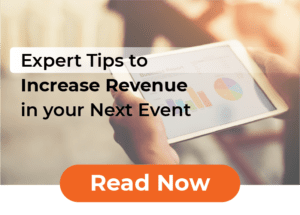Events are excellent opportunities for brands and companies to connect with their target audiences and create business opportunities. Organizations take great efforts and make enormous investments to exhibit and meet potential customers at trade shows. But at the end of it all, the only things that matter are the results. What was achieved from investing such a large portion of the marketing budget and having the whole team work on it?
Measuring event ROI has always been subjective because there are many ways to quantify it. Some marketers define their success from the number of badges they scanned while others may use qualitative survey data. Event ROI metrics usually focus on the aspects of your event strategy you are paying most attention to. In this blog, we look at 4 metrics that event planners now use more often to measure and maximize event ROI.
Sales pipeline
Companies spend hundreds of thousands of dollars on attending trade shows. This means that they see the enormous business potential they have to interact with customers and prospects and get deals signed.
When tracked properly through the event lifecycle, sales pipeline can directly influence event ROI. Over the course of the event, sales reps interact with hundreds of existing and potential customers. Reverse engineering your sales process can help you understand the efforts that are needed to measure and establish your event ROI. Use your historical CRM data to establish your conversion rate. With that in mind, you can determine the number of meetings you need to ensure that you reach your goal. Track every sales meeting that happens at your event and ensure you capture the pipeline impact of every meeting. If this is done rigorously, by the end of the event you will realize you helped build millions of dollars worth of business at each of your events.
Meeting room /space utilization
Meeting rooms might seem like an unlikely place to establish event ROI but there are a number of talking points that come up when analyzing meeting room data. They are the focal point of any event exhibit. At any point you have several customer meetings, product demonstrations and prospect presentations going on at the exhibit. Capturing and measuring space utilization data can tell you how much you are getting in return for investing in the exhibit space. Some companies even calculate the per-hour value of meeting space and only if a meeting’s revenue potential exceeds the cost, does the meeting get approved.
Executive / Sales rep utilization
Much like meeting rooms, you can also tie the efficiency of sales reps to event ROI objectives. The number of meetings that sales rep or executive does during the event determines whether or not they are needed at this same event next year. By co-relating pipeline data with per rep meetings data, you can also identify your top performing sales reps and which executives are best meeting influencers. These data points help you identify how many and who you need to fly to your next event as well.
Social media engagement
If spreading brand awareness is your objective, social media monitoring is an excellent tool. A number of organizations engage with customers before and after an event, but fail to recognize the importance of engaging with their audiences during an event. Social media traffic is just as important as booth traffic. Essentially, the more traffic you get, the more attention your brand receives. As a first step, ensure some of the activities set up at the exhibit are more tweet-worthy (e.g. wackiest selfie contests, money machines, photo booths) than the others (e.g. meetings / product demos)
Analyze your Twitter activity and take a note of the tweets that have the most retweets and comments. This can help you clearly understand what resonates with your audience. Also, based on the window with the most tweets, you can also narrow down on the best time to engage with them. With a bit of research, you can gather some important leads from Twitter and create an email campaign to help convert them.
One of the biggest challenges that event marketers face is accessing larger event marketing budgets. The only way they can convince CMOs to continue investing in events is by showing them that the investment is being put to good use by bringing in substantial returns. Using these metrics at events, not only ensures that you’re effectively measuring event ROI, but also helps you gather information that can prove vital to achieving and exceeding your targets.



